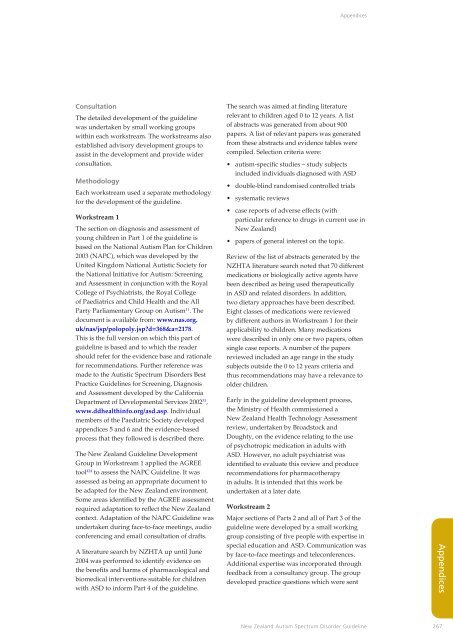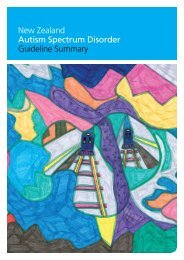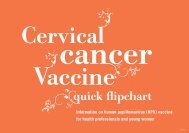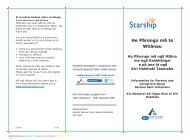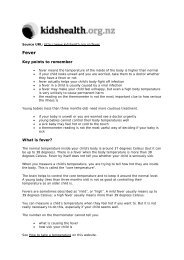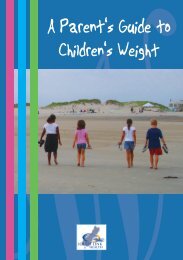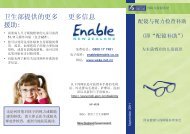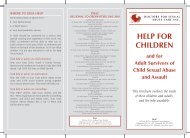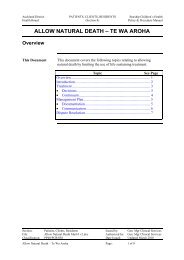New Zealand Autism Spectrum Disorder Guideline - Ministry of Health
New Zealand Autism Spectrum Disorder Guideline - Ministry of Health
New Zealand Autism Spectrum Disorder Guideline - Ministry of Health
Create successful ePaper yourself
Turn your PDF publications into a flip-book with our unique Google optimized e-Paper software.
Appendices<br />
Consultation<br />
The detailed development <strong>of</strong> the guideline<br />
was undertaken by small working groups<br />
within each workstream. The workstreams also<br />
established advisory development groups to<br />
assist in the development and provide wider<br />
consultation.<br />
Methodology<br />
Each workstream used a separate methodology<br />
for the development <strong>of</strong> the guideline.<br />
Workstream 1<br />
The section on diagnosis and assessment <strong>of</strong><br />
young children in Part 1 <strong>of</strong> the guideline is<br />
based on the National <strong>Autism</strong> Plan for Children<br />
2003 (NAPC), which was developed by the<br />
United Kingdom National Autistic Society for<br />
the National Initiative for <strong>Autism</strong>: Screening<br />
and Assessment in conjunction with the Royal<br />
College <strong>of</strong> Psychiatrists, the Royal College<br />
<strong>of</strong> Paediatrics and Child <strong>Health</strong> and the All<br />
Party Parliamentary Group on <strong>Autism</strong> 11 . The<br />
document is available from: www.nas.org.<br />
uk/nas/jsp/polopoly.jsp?d=368&a=2178.<br />
This is the full version on which this part <strong>of</strong><br />
guideline is based and to which the reader<br />
should refer for the evidence base and rationale<br />
for recommendations. Further reference was<br />
made to the Autistic <strong>Spectrum</strong> <strong>Disorder</strong>s Best<br />
Practice <strong>Guideline</strong>s for Screening, Diagnosis<br />
and Assessment developed by the California<br />
Department <strong>of</strong> Developmental Services 2002 33 ,<br />
www.ddhealthinfo.org/asd.asp. Individual<br />
members <strong>of</strong> the Paediatric Society developed<br />
appendices 5 and 6 and the evidence-based<br />
process that they followed is described there.<br />
The <strong>New</strong> <strong>Zealand</strong> <strong>Guideline</strong> Development<br />
Group in Workstream 1 applied the AGREE<br />
tool 424 to assess the NAPC <strong>Guideline</strong>. It was<br />
assessed as being an appropriate document to<br />
be adapted for the <strong>New</strong> <strong>Zealand</strong> environment.<br />
Some areas identified by the AGREE assessment<br />
required adaptation to reflect the <strong>New</strong> <strong>Zealand</strong><br />
context. Adaptation <strong>of</strong> the NAPC <strong>Guideline</strong> was<br />
undertaken during face-to-face meetings, audio<br />
conferencing and email consultation <strong>of</strong> drafts.<br />
A literature search by NZHTA up until June<br />
2004 was performed to identify evidence on<br />
the benefits and harms <strong>of</strong> pharmacological and<br />
biomedical interventions suitable for children<br />
with ASD to inform Part 4 <strong>of</strong> the guideline.<br />
The search was aimed at finding literature<br />
relevant to children aged 0 to 12 years. A list<br />
<strong>of</strong> abstracts was generated from about 900<br />
papers. A list <strong>of</strong> relevant papers was generated<br />
from these abstracts and evidence tables were<br />
compiled. Selection criteria were:<br />
• autism-specific studies – study subjects<br />
included individuals diagnosed with ASD<br />
• double-blind randomised controlled trials<br />
• systematic reviews<br />
• case reports <strong>of</strong> adverse effects (with<br />
particular reference to drugs in current use in<br />
<strong>New</strong> <strong>Zealand</strong>)<br />
• papers <strong>of</strong> general interest on the topic.<br />
Review <strong>of</strong> the list <strong>of</strong> abstracts generated by the<br />
NZHTA literature search noted that 70 different<br />
medications or biologically active agents have<br />
been described as being used therapeutically<br />
in ASD and related disorders. In addition,<br />
two dietary approaches have been described.<br />
Eight classes <strong>of</strong> medications were reviewed<br />
by different authors in Workstream 1 for their<br />
applicability to children. Many medications<br />
were described in only one or two papers, <strong>of</strong>ten<br />
single case reports. A number <strong>of</strong> the papers<br />
reviewed included an age range in the study<br />
subjects outside the 0 to 12 years criteria and<br />
thus recommendations may have a relevance to<br />
older children.<br />
Early in the guideline development process,<br />
the <strong>Ministry</strong> <strong>of</strong> <strong>Health</strong> commissioned a<br />
<strong>New</strong> <strong>Zealand</strong> <strong>Health</strong> Technology Assessment<br />
review, undertaken by Broadstock and<br />
Doughty, on the evidence relating to the use<br />
<strong>of</strong> psychotropic medication in adults with<br />
ASD. However, no adult psychiatrist was<br />
identified to evaluate this review and produce<br />
recommendations for pharmacotherapy<br />
in adults. It is intended that this work be<br />
undertaken at a later date.<br />
Workstream 2<br />
Major sections <strong>of</strong> Parts 2 and all <strong>of</strong> Part 3 <strong>of</strong> the<br />
guideline were developed by a small working<br />
group consisting <strong>of</strong> five people with expertise in<br />
special education and ASD. Communication was<br />
by face-to-face meetings and teleconferences.<br />
Additional expertise was incorporated through<br />
feedback from a consultancy group. The group<br />
developed practice questions which were sent<br />
Appendices<br />
<strong>New</strong> <strong>Zealand</strong> <strong>Autism</strong> <strong>Spectrum</strong> <strong>Disorder</strong> <strong>Guideline</strong> 267


